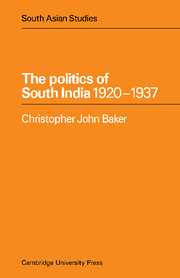Book contents
- Frontmatter
- Contents
- List of maps and tables
- Preface
- Notes on references, transliteration and abbreviations
- 1 Madras Presidency–natural features, regions and languages
- 2 Madras Presidency – districts
- 3 Madras Presidency – municipal towns
- 1 Politics and the Province: the Justice party
- 2 The province and the locality
- 3 Depression, dissent and disengagement
- 4 The ascent of the congress
- Conclusion
- Biographical notes
- Glossary
- Bibliography
- Index
- Frontmatter
- Contents
- List of maps and tables
- Preface
- Notes on references, transliteration and abbreviations
- 1 Madras Presidency–natural features, regions and languages
- 2 Madras Presidency – districts
- 3 Madras Presidency – municipal towns
- 1 Politics and the Province: the Justice party
- 2 The province and the locality
- 3 Depression, dissent and disengagement
- 4 The ascent of the congress
- Conclusion
- Biographical notes
- Glossary
- Bibliography
- Index
Summary
The British government in south India in the mid-nineteenth century was perched over a society which was closely controlled by those with mastery over its slowly developing economy. Between the governors and the mass of the governed was interposed a stratum of local leaders and subordinate Indian administrators. This stratum insulated the government from the problems and protests of local society, and helped to give to south India an appearance of enduring calm; but it also locked government out of its own administrative system and hindered government attempts to encourage change.
Towards the end of the century, under the pressure of financial and administrative needs, government was forced down more firmly on the society. Government took on many new roles and government intruded into the backyard of many more of the population. Government also became far more important as a controller of men and resources. An equal and opposite reaction was bound to follow.
The new administrative machinery tied together in a much firmer fashion than before the parts of what had been an immensely disparate and fragmented province; it united the Madras Presidency as a political unit centred on the provincial capital. Power had been withdrawn from the districts and relocated in the institutions in Madras City. Thus in the early years of the twentieth century, the political temperature of the provincial capital rose dramatically. Government provided opportunities for Indians to spread their political influence over an area which, until the British had created the province and now pulled it together, had never existed as a unit before.
- Type
- Chapter
- Information
- The Politics of South India 1920–1937 , pp. 320 - 326Publisher: Cambridge University PressPrint publication year: 1976



